| |||||
| Decades: | |||||
|---|---|---|---|---|---|
| See also: | |||||
The following lists events that happened during 2006 in the Gambia .
| |||||
| Decades: | |||||
|---|---|---|---|---|---|
| See also: | |||||
The following lists events that happened during 2006 in the Gambia .

Senegal, officially the Republic of Senegal, is the westernmost country in West Africa, situated on the Atlantic Ocean coastline. Senegal is bordered by Mauritania to the north, Mali to the east, Guinea to the southeast and Guinea-Bissau to the southwest. Senegal nearly surrounds The Gambia, a country occupying a narrow sliver of land along the banks of the Gambia River, which separates Senegal's southern region of Casamance from the rest of the country. Senegal also shares a maritime border with Cape Verde. Senegal's economic and political capital is Dakar.
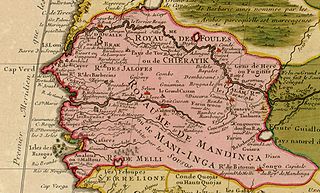
The history of Senegal is commonly divided into a number of periods, encompassing the prehistoric era, the precolonial period, colonialism, and the contemporary era.

Casamance is the area of Senegal south of the Gambia, including the Casamance River. It consists of the Lower Casamance and the Upper Casamance. The largest city of Casamance is Ziguinchor.

Senegambia, officially the Senegambia Confederation or Confederation of Senegambia, was a loose confederation in the late 20th century between the West African countries of Senegal and its neighbour The Gambia, which is almost completely surrounded by Senegal. The confederation was founded on 1 February 1982 following an agreement between the two countries signed on 12 December 1981. It was intended to promote cooperation between the two countries, but was dissolved by Senegal on 30 September 1989 after The Gambia refused to move closer toward union. The Senegambia Confederation should not be confused with the historic Senegambia region, generally shortened to the Senegambia.
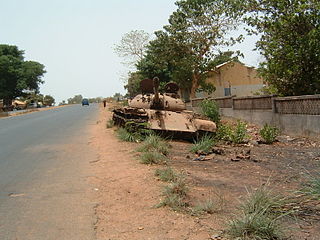
The Guinea-Bissau Civil War was fought from 7 June 1998 to 10 May 1999 and was triggered by an attempted coup d'état against the government of President João Bernardo Vieira led by Brigadier-General Ansumane Mané. Government forces, backed by neighbouring states, clashed with the coup leaders who had quickly gained almost total control over the country's armed forces.

The Casamance conflict is an ongoing low-level conflict that has been waged between the Government of Senegal and the Movement of Democratic Forces of Casamance (MFDC) since 1982. On May 1, 2014, the leader of the MFDC sued for peace and declared a unilateral ceasefire.
Kukoi Samba Sanyang was a Gambian politician and leader of the unsuccessful 1981 coup d'état against the government of Dawda Jawara.

The Trans-Gambia Highway is a major highway in The Gambia, running across the centre of the nation in a north–south direction.

Guinea-Bissau Creole, also known as Kiriol or Crioulo, is a creole language whose lexicon derives mostly from Portuguese. It is spoken in Guinea Bissau, Senegal and The Gambia. It is also called by its native speakers as guinensi, kriyol, or portuguis.
Father Augustin Diamacoune Senghor was a Catholic priest and a leading figure in the Casamance independence movement from Senegal. He served as director of the Saint-Louis of Ziguinchor Seminary from 1972 until 1975.
The Bainuk people are an ethnic group that today lives primarily in Senegal as well as in parts of Gambia and Guinea-Bissau.
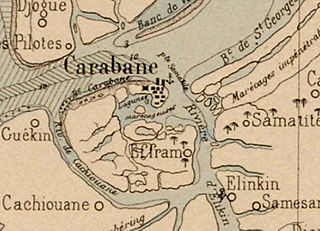
Carabane, also known as Karabane, is an island and a village located in the extreme south-west of Senegal, in the mouth of the Casamance River. This relatively recent geological formation consists of a shoal and alluvium to which soil is added by accumulation in the branches and roots of the mangrove trees which cover most of the island. Along with the rest of Ziguinchor Region, Carabane has a tropical climate, cycling between a dry season and a wet season. The island was once considered an arid location where no useful plants were likely to grow, but it now supports several types of fruit tree, the most common of which are mangos and oranges. Although the nearby Basse Casamance National Park and Kalissaye Avifaunal Reserve have been closed for years because of the Casamance Conflict, Carabane has continued to attract ornithologists interested in its wide variety of birds. Various species of fish are plentiful around the island, but there are very few mammals.
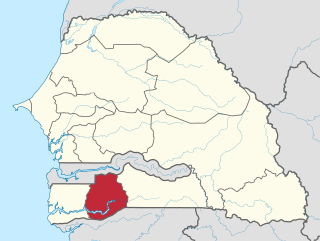
Sédhiou Region is a region of Senegal located in the southwest of the country in the natural region called Casamance.
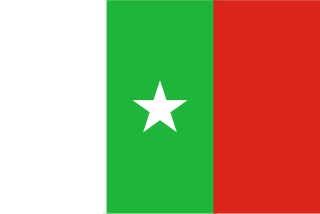
The Movement of Democratic Forces of Casamance is the main separatist movement in the Casamance region of Senegal, founded in 1982. It was supported by Guinea-Bissau President João Bernardo Vieira until he was overthrown in 1999. It relies mainly on the Jola people. Its armed wing was formed in 1985 and is called Atika.

Ziguinchor is the capital of the Ziguinchor Region, and the chief town of the Casamance area of Senegal, lying at the mouth of the Casamance River. It has a population of 214,874. It is the eighth largest city of Senegal, but is nearly separated from the north of the country by the nation of The Gambia.

Fuladu or Fuladugu is a historic region and former Fula kingdom in the Upper Casamance, in the south of Senegal, and including certain areas in The Gambia and Guinea-Bissau. It was the last independent pre-colonial state in the area, ceasing to exist in 1903.
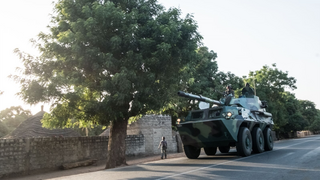
The ECOWAS military intervention in the Gambia or the ECOWAS Mission in The Gambia – initially code-named Operation Restore Democracy – is a military intervention in The Gambia by several member states of the Economic Community of West African States.
Events in the year 2018 in the Gambia.

The Senegambia bridge, also known as the Trans-Gambia Bridge, is a bridge in The Gambia that carries the Trans-Gambia Highway connecting northern and southern Gambia. It also provides access to the isolated Casamance province from the rest of Senegal. A bridge had been proposed for this location in 1956 but political considerations delayed construction which finally began in 2015. Construction was funded largely by a loan of US$ 65 million from the African Development Bank, with remaining funding coming from the Gambian government. Construction works were carried out by a joint venture of Spanish company Isolux Corsán and the Senegalese Arezki Group.
Wolofization or Wolofisation is a cultural and language shift whereby populations or states adopt Wolof language or culture, such as in the Senegambia region. In Senegal, Wolof is a lingua franca The Wolofization phenomenon has taken over all facets of Senegal and encroaching on Gambian soil. This phenomenon has caused other Senegambian ethnic groups great concern and resulted in taking steps to preserve their languages and culture. In this regard, the Serer ethnic group who have had a long history fighting against Islamization and Wolofization have been taking active steps in the past decades by setting up associations and other organisations in order to preserve their languages, culture and "ancient religious past." Haalpulaar speakers, namely the Fula and Toucouleur have also been taking steps to preserve their language.